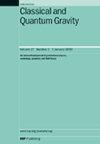克尔黑洞旋转能量的转换
IF 3.6
3区 物理与天体物理
Q2 ASTRONOMY & ASTROPHYSICS
引用次数: 0
摘要
本文通过 "弹道法 "分析了克尔黑洞(BH)旋转能量提取的反馈,即罗杰-彭罗斯(Roger Penrose)开创的BH极圈中的测试粒子衰变。重点是负能量反旋转粒子(可以是大质量或无质量粒子)进入地平线,并评估其对黑洞不可还原质量的反馈。一般来说,不可还原质量的变化是粒子守恒量的函数。对于极端克尔黑洞,在极限情况下,所有减少的可转化能量都会进入不可还原质量(即 ),从而导致高度不可逆。利用测试粒子从 BH 提取的能量远低于可转化能量的变化。对于非极端的克尔玻赫,分析了粒子在克尔时空中赤道面上运动的有效势能,证明只有当衰变点与转折点重合时,具有无量纲自旋的玻赫才能经历彭罗斯过程。在此基础上,提供了不可还原质量变化的下限与 BH 无量纲自旋的函数关系。通过引入玻色子可转化能量的概念,概括而简洁地说明了在能量提取过程中玻色子不可还原质量增加的意义。彭罗斯过程对不可还原质量的反馈表明了能量萃取的不可逆性,并强调了可以从一个玻色体中萃取的能量总量比之前预计的要少。本文章由计算机程序翻译,如有差异,请以英文原文为准。
The transformation of the rotational energy of a Kerr black hole
This paper analyzes the feedback of the rotational energy extraction from a Kerr black hole (BH) by the ‘ballistic method’, i.e. the test particle decay in the BH ergosphere pioneered by Roger Penrose. The focus is on the negative energy counterrotating particles (which can be massive or massless) going in towards the horizon, and the feedback on the BH irreducible mass is assessed. Generally, the change in irreducible mass is a function of the conserved quantities of the particle. For an extreme Kerr BH and in the limit , all the reduced transformable energy goes into the irreducible mass (i.e. ), resulting in high irreversibility. The amount of extracted energy from the BH using test particles is much lower than the change of transformable energy. For non-extreme Kerr BHs, the effective potential of particle motion on the equatorial plane in Kerr spacetime is analyzed, and it is demonstrated that the Penrose process can only be undergone by BHs with a dimensionless spin if the decay point coincides with the turning point. Based on that, the lower limit of the change in irreducible mass is provided as a function of the dimensionless spin of the BH. The significance of the increase in the irreducible mass of the BH during the energy extraction process is generally and concisely illustrated by introducing the concept of transformable energy of the BH. The feedback from the Penrose process on the irreducible mass demonstrates the irreversibility of energy extraction and highlights that the total amount of energy that can be extracted from a BH is less than previously anticipated.
求助全文
通过发布文献求助,成功后即可免费获取论文全文。
去求助
来源期刊

Classical and Quantum Gravity
物理-天文与天体物理
CiteScore
7.00
自引率
8.60%
发文量
301
审稿时长
2-4 weeks
期刊介绍:
Classical and Quantum Gravity is an established journal for physicists, mathematicians and cosmologists in the fields of gravitation and the theory of spacetime. The journal is now the acknowledged world leader in classical relativity and all areas of quantum gravity.
 求助内容:
求助内容: 应助结果提醒方式:
应助结果提醒方式:


